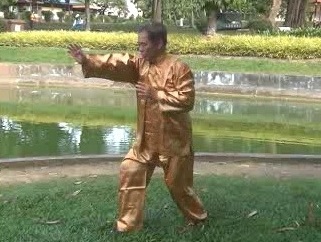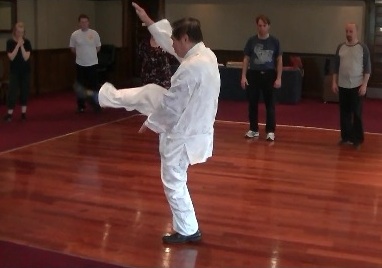SELECTION OF QUESTIONS AND ANSWERS
FEBRUARY 2014 PART 3

Yue Fei -- the God of Martial Arts
Question 1
In a Q&A series you say that:
"Shen refers to the body and xin refers to the heart."
I remember you teaching us that the spirit is related to the heart. So is "shen" referred to the "spirit living in the heart" or the body?
— Andreas, Austria
Answer
The problem is due to the Romanized spelling of the words and the tone the words are pronounced. "Shen" meaning spirit is pronounced in the third tone, whereas "shen" meaning body is pronounced in the first tone, but their Romanized spellings are the same though the written words in Chinese and meanings are different.
In written Chinese, "shen" meaning spirit is written differently from "shen" meaning body. The two words are also pronounced differently.
Xin, which can also means "heart", here refers to the spirit, and not to the organ heart.
In the Chinese paradigm, a person is made up of two components, namely "shen" meaning body, and "xin" meaning heart which includes the emotional, mental and spiritual aspects in the Western paradigm.
Question 2
I study a style called Yue Chia. My Sifu was taught the style in Japan. All I know about this style is what has been provided to me from my Sifu. My Sifu says that according to legend, the Shaolin Master, Priest Yue, combined what he thought were the most effective living and fighting strategies of the original Shaolin five Animal styles into one; the style that came to be known as Yue Chia.
Having said that, I was wondering if you had any more info on this style, and if so if you would be able to steer me toward it?
— Brinkley, USA
Answer
"Yue Chia", or "Yue Jia" in Romanized Chinese, means "Yue Family", and it refers to the family style of kingfu that originated from Yue Fei who lived in the 12th century during the Song Dynasty.
Yue Fei was not a priest, but a famous marshal who successfully defended against attacks from the Tartars. Yue Fei learned from a Shaolin master named Zhou Tong.
Yue Fei was a great kungfu master. He was deified as the God of Martial Art.
Yue Fei invented three kungfu styles, namely Eagle Claw Kungfu, Xingyiquan or Hsing Yi Kungfu, and Yue Jia Kungfu.
I don't think Yue Fei combined the five Shaolin animals into Yue Jia Kungfu. Yue Jia Kungfu is simple and direct, and overtly forceful. It does not have the characteristics of the Shaolin five animals, which are sophisticated and elaborate. Yue Jia Kungfu resembles more of Xingyiquan without the latter’s twelve animal forms. This makes Yue Jia Kungfu even more simple and direct than Xingyiquan.
A special feature of Yue Jia Kungfu is the big boss fist, which is also called the elephant fist. It is formed by protruding the knuckle of the middle finger in a fist. (By comparison, in the phoenix-eye fist, the knuckle of the second finger is protruded.)
Today, many Yue Jia practitioners are Cantonese speaking. Hence, Yue Jia Kungfu is more commonly known by its Cantonese pronunciation of Ngok Ka Kungfu.
My childhood friend, Sifu Chow Kok Chee, who is a terrific fighter, is an expert in Ngok Ka Kungfu, which he used in his more than 200 fights, many of which were of life-death consequences. Sifu Chow and I exchanged some kungfu training methods. Two close-door secrets of Ngok Ka Kungfu I derived from this exchange with Sifu Chow were Pa Wong Khun or Big Boss Fist and Thiew Hang Kung or Art of Suspended Practice.
Big Boss Fist is a fundamental set of Ngok Ka Kungfu. It is direct, forceful and aggressive. It is similar to Xingyiquan with mainly crushing fist and the cannon fist, except that the big boss fist instead of the vertical fist is used.
The Art of Suspended Practice is an exclusive art, hence it is little known outside informed circles. Only Ngok Ka practitioners of many years who have won the trust of the master have a chance to practice this force-training method. It is very powerful, and I believe derived from Sinew Metamorphosis.
It is easy to practice it wrongly, and the adverse effects can be very drastic. I remember that in my young days when I was training under Uncle Righteousness, the son-in-law of a Ngok Ka master who was nurtured to succeed the master, trained this art wrongly and he vomited blood.
He met me, but unfortunately at a time when I was not well versed in chi kung healing yet. I was shocked seeing him. He was pale and could hardly speak, a far cry from the time when he was a picture of vitality in his prime kungfu days. Had he seen me or any one of our chi kung healers now, he would recover in a few weeks. This was one of the few regrets I have had in life that I could not help him then. He was such a fine kungfu exponent.

Grandmaster Wong performing Xingyiquan
Question 3
Firstly I would like to thank you for taking the time to make this fantastic resource available to the public. I have carefully read your books "The Art of Chi Kung" and "Shaolin KungFu" and found them very informative and helpful to my practice. Especially with the index, your website is a real treasure trove of information.
— Aaron, England
Answer
I have written three books on Shaolin Kungfu, namely "Introduction to Shaolin Kungfu", "The Art of Shaolin Kung Fu", and "The Complete Book of Shaolin".
Many people have kindly remarked that my website is an encyclopaedia for chi kung, Shaolin, Taijiquan and Zen. Besides the index, you can also find information related to specific topics by using the search box on my website.
Question 4
I am a student of Chen Taijichuan of twelve years, having previously trained in Wing Chun and Western Boxing.
Answer
I would recommend that you attend my Intensive Tai Chi Chuan Course. You will be amazed at what you will learn and achieve in just a few days.
Amongst other things, you will learn in just a few days how to develop internal force, and how to apply typical Taijiquan patterns for combat, thus actualizing Taijiquan as an internal, martial art.

Grandmaster Wong performing Chen Style Taijiquan
Question 5
I would like to ask some questions relating to horse stance practice. You say that five minutes is a basic requirement. Looking at pictures of your stance I see that your thighs are almost parallel with the ground. I see in other pictures on your website however that your students are standing in a higher stance, with thighs more like 45 degrees to the ground.
My question is, when you state the requirement of five minutes, does this relate to the higher or lower stance? In my experience the lower stance is much more demanding. I’m currently standing for about three and a half minutes in the lower position. My immediate goal is five minutes. However I’ve come to realize that achieving perfect form with relaxation and mental focus is more important than the time the stance is held.
Answer
When I first learned kungfu many years ago, my Horse-Riding Stance was low, with my thighs parallel to the ground. Much later I discovered that if I maintained a pyramid shape instead of a box shape for my Horse-Riding Stance, with my thighs about 30 degrees instead of 90 degrees, I could develop more internal force, besides it being easier to practice.
My students’ stance is quite high, about 45 degrees, when they begin training. As they progress as chi sinks down to their dan tian, they will spontaneously lower their stance to about 30 degrees.
The five-minute requirement relates to the stance at its optimum position, i.e. about 30 degrees. You are right that picture-perfect form, relaxation and mental focus are more important. If you find standing (or sitting) at 30 degrees too demanding, you can start at about 45 degrees.
When you practice correctly, stance training gives you not only internal force but also mental clarity – two ingredients that are important not just for martial art but for daily living.
Question 6
I find it interesting that the physical aspect of horse stance training seems to correspond to so called “isometrics” in Western parlance; i.e. muscles bear weight but don’t move. One drawback of this otherwise effective exercise is said to be that the benefits relate only to the position held.
Answer
Stance training should not be isometrics. The more relaxed you are, which means your muscles should not bear weight, the better the result will be.
It is difficult for most people to understand this important advice because they are used to the concept of muscular strength, but all internal art masters give the same advice.

Sifu Chris performing the Horse-Riding Stance
Question 7
In my experience of traditional stance training the three most common stances, i.e, Horse, Bow and Arrow, and False Leg, are often held at a different angle of the thighs; around 90, 45 and 30 degrees respectively, and together should provide a complete workout.
Answer
Presuming all other factors being equal, the Horse-Riding Stance gives you the best result in developing internal force. If you spend 5 minutes for each stance, for example, the amount of internal force you derive from the Horse Stance can be twice that from the Bow-Arrow Stance, and three times that from the False-Leg Stance.
The reason is that the Horse Stance being symmetrical, it is more effective in collecting energy from the Cosmos.
Question 8
I've also been practicing my stances using two rucksacks loaded with weights, one on the front and one on the back for balance. What is your opinion of this practice?
Answer
This is not recommended.
You will understand the reason if you know why stance training develops internal force -- a question even masters may not know the answer though they have developed internal force from dedicated training.
The posture of the Horse Stance is such that if you are relaxed and not thinking of anything, energy from the Cosmos will spontaneously flow in to be collected at your dan tian as well as root you to the ground. This is spontaneous. You don't have to do anything and you don't have to do any extra.
But you need to be relaxed and not thinking of anything. If you tense any muscles, you block the energy flow. If you start thinking, you also block the energy flow.
Hanging two rucksacks loaded with weight affect your relaxation. They may make you feel more rooted because of their weight, besides helping you to keep balance, but you will be collecting much less energy from the Cosmos. It is the cosmic energy built at your dan tian that provides you with internal force.
LINKS
Selected Reading
- Is it not true that there is only one Truth and one God?
- Purifying Intellect, Body and Soul
- Shaolin 72 Chin-Na Techniques
- What is Wahnam Taijiquan
- Shaolin Kungfu against Western Boxing
